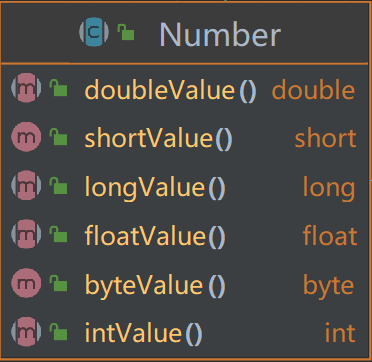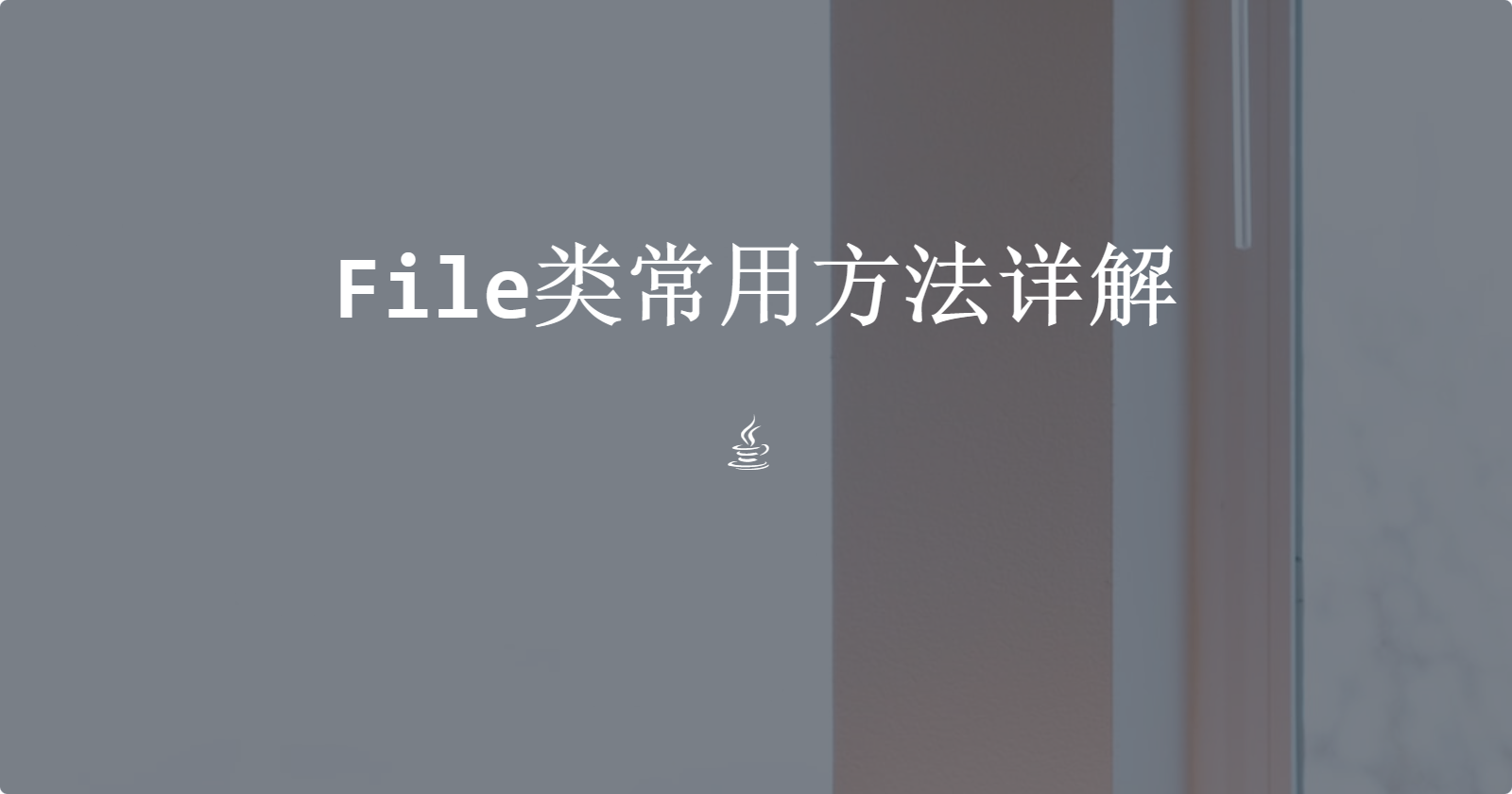包装类常用方法详解
八大包装类
java有八种包装类
| 基本数据类型 | 包装类 |
|---|---|
| boolean | Boolean |
| char | Character |
| byte | Byte |
| short | Short |
| int | Integer |
| long | Long |
| float | Float |
| double | Double |
装箱和拆箱
基本概念
- 装箱:基本数据类型转换成对应的包装类
- 拆箱:包装类转换成对应的基本数据类型
手动装箱和手动拆箱
手动装箱
有两种方式
- 通过Integer构造方法
- 通过Integer的valueOf方法
1 | |
手动拆箱
使用intValue方法
1 | |
自动装箱和自动拆箱
在jdk5之后,可以自动装箱和自动拆箱,即可以使用=直接赋值
以Integer和int为例,演示自动装箱和自动拆箱
自动装箱
1 | |
自动拆箱
1 | |
Number接口方法
除Character和Boolean以外的六大包装类都实现了Number接口
Number方法全部如下
作用:可以将包装类转换成指定的基本数据类型

演示
1 | |
Number型包装类通用
这里的这些方法在Integer、Double、Float、Byte、Long、Short这些Number型包装类中通用的,但是这些方法在不同的包装类上又有些差别,注意甄别
以Integer为例演示
toOctalString
有此方法的包装类:Integer、Long,但是细节不一样
将int整数转换成八进制字符串
public static String toOctalString(int i)
1 | |
toBinaryString
有此方法的包装类:Integer、Long,但是细节不一样
将int整数转换成二进制字符串
public static String toBinaryString(int i)
1 | |
toHexString
有此方法的包装类:Integer、Long、Double、Float,但是细节不一样
有此方法的包装类:Integer、Long、
将int整数转换成十六进制字符串
public static String toHexString(int i)
1 | |
toString
有此方法的包装类:Integer、Long、Double、Float、Short、Byte,但是细节不一样
将int整数转换成字符串
有三种重载形式
-
public String toString()默认形式,原样转换字符串,通过Integer对象调用
-
public static String toString(int i)这个是静态方法,可以通过类名调用
-
public static String toString(int i, int radix)
这个可以指定转换为几进制数(任意进制)的字符串,通过radix指定
1 | |
compare
有此方法的包装类:Integer、Long、Double、Float、Short、Byte,但是细节不一样
比较两个int数的大小
- x < y,结果为-1
- x > y,结果为1
- x = y,结果为0
public static int compare(int x, int y)
1 | |
max
有此方法的包装类:Integer、Long、Double、Float、Short、Byte,但是细节不一样
返回a和b中较大者
public static int max(int a, int b)
1 | |
min
有此方法的包装类:Integer、Long、Double、Float、Short、Byte,但是细节不一样
返回a和b较小者
public static int min(int a, int b)
1 | |
sum
有此方法的包装类:Integer、Long、Double、Float、Short、Byte,但是细节不一样
计算a和b的和
public static int sum(int a, int b)
1 | |
valueOf
有此方法的包装类:Integer、Long、Double、Float、Short、Byte,但是细节不一样
也是进行类型转换,只不过是转换成Integer
有三种重载形式
-
public static Integer valueOf(int i)将int转换为Integer
-
public static Integer valueOf(String s)将String转换为Integer
-
public static Integer valueOf(String s, int radix)指定String的基数,将String转换为Integer
1 | |
praseXXX
praseXXX这个方法代表一类方法
具体有:parseInt|praseLong|praseDouble|praseFloat|praseShort|praseByte
结合具体包装类名称命名
有此方法的包装类:Integer、Long、Double、Float、Short、Byte,但是细节不一样
以parseInt为例
将字符串转换为int整数
有两种重载形式
-
public static int parseInt(String s)将字符串转化为int整数,默认方式
-
public static int parseInt(String s, int radix)指定字符串s的进制,将其转换成int整数
1 | |
isFinite
有此方法的包装类:Double、Float
判断浮点数是否有限
有限返回true,无限(无穷大)返回false
以Double为例
public static boolean isFinite(double d)
1 | |
isInfinite
有此方法的包装类:Double、Float
判断浮点数是否无限(无穷大)
无限(无穷大返回true),有限返回false
以Double为例
public static boolean isInfinite(double v)
1 | |
isNaN
有此方法的包装类:Double、Float
判断浮点数是否为number
是number返回false,不是number返回true
以Double为例
1 | |
Integer、Byte、Short、Long、Float、Double常用方法
Boolean常用方法
praseBoolean、compare、toString、valueOf
虽然Boolean不属于Number型,但是这些方法和Number型是通用的
getBoolean
该方法用于判断系统属性字符串是否为"true"
当且仅当系统属性存在,且值等于 “true” 时,才返回 true
public static boolean getBoolean(String name)
1 | |
logicalAnd
返回a和b的逻辑与
public static boolean logicalAnd(boolean a, boolean b)
1 | |
logicalOr
返回a和b的逻辑或
public static boolean logicalOr(boolean a, boolean b)
1 | |
logicalXor
返回a和b的异或
public static boolean logicalXor(boolean a, boolean b)
1 | |
Character常用方法
Character提供了非常多的字符判断功能,可以实现各种各样的字符判断
isLowerCase
用于判断字符是否为小写
该方法有两种重载形式
-
public static boolean isLowerCase(char ch)判断字符ch是否为小写
-
public static boolean isLowerCase(int codePoint)
判断Unicode编码对应的字符是否为小写
1 | |
isUpperCase
用于判断字符是否为大写
该方法有两种重载形式
-
public static boolean isUpperCase(char ch)判断字符ch是否为大写
-
public static boolean isUpperCase(int codePoint)
判断Unicode编码对应的字符是否为大写
1 | |
isDigit
用于判断字符是否为数字
该方法有两种重载形式
-
public static boolean isDigit(char ch)判断字符ch是否为数字
-
public static boolean isDigit(int codePoint)
判断Unicode编码对应的字符是否为数字
1 | |
isLetter
用于判断字符是否为字母
该方法有两种重载形式
-
public static boolean isLetter(char ch)判断字符ch是否为字母
-
public static boolean isLetter(int codePoint)
判断Unicode编码对应的字符是否为字母
1 | |
isLetterOrDigit
用于判断字符是否为字母或数字
该方法有两种重载形式
-
public static boolean isLetterOrDigit(char ch)判断字符ch是否为字母或数字
-
public static boolean isLetterOrDigit(int codePoint)
判断Unicode编码对应的字符是否为字母或数字
1 | |
isWhiteSpace
用于判断字符是否为空格
该方法有两种重载形式
-
public static boolean isWhiteSpace(char ch)判断字符ch是否为空格
-
public static boolean isWhiteSpace(int codePoint)
判断Unicode编码对应的字符是否为空格
1 | |
toUpperCase
将小写字母转换成大写
该方法有两种重载形式
-
public static char toUpperCase(char ch)将字符ch转换成大写
-
public static int toUpperCase(int codePoint)将Unicode编码对应的字符转换成大写,返回大写后的Unicode码
1 | |
toLowerCase
将大写字母转换成小写
该方法有两种重载形式
-
public static char toLowerCase(char ch)将字符ch转换成小写
-
public static int toLowerCase(int codePoint)
将Unicode编码对应的字符转换成小写,返回小写后的Unicode码
1 | |











